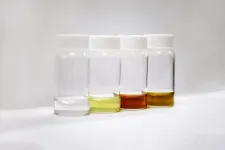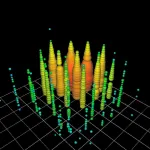INFORMATION:
The research was funded by the National Institutes of Health's NIDDK (R01DK103363 and R01DK115986), the Cancer Prevention and Research Institute of Texas, and The Welch Foundation. A patent application has been filed on the technology.
The multiyear project was initiated by Xingya Jiang PhD'19, who is now a postdoctoral research fellow at Harvard Medical School/Brigham and Women's Hospital, and was continued by Qinhan Zhou, a PhD candidate in chemistry at UT Dallas. Other authors include Bujie Du PhD'19, a postdoctoral associate at the Massachusetts Institute of Technology; chemistry doctoral students Siqing Li and Yingyu Huang; Dr. Mengxiao Yu, research associate professor of chemistry; and Dr. Zhikai Chi, assistant professor of pathology at UT Southwestern.
Study shows simple blood test could detect liver injury earlier
Researchers describe how gold nanoparticles may play part in finding damage
2021-03-10
(Press-News.org) University of Texas at Dallas chemist Dr. Jie Zheng has spent much of his career investigating gold nanoparticles for their potential impact in the field of nanomedicine. In new research, he and his colleagues show how these nanoparticles could play a key role in a simple blood test to detect acute liver damage earlier than current methods.
The study, published online Feb. 19 in the journal Science Advances, expands on corresponding author Zheng's work, which has previously demonstrated the use of nanoparticles for targeted delivery of cancer drugs and better understanding of kidney disease.
"Our goal is to make it simple for family doctors to easily catch liver injury earlier. If they can detect and treat such injury earlier, the patient has a better chance of faster recovery," said Zheng, professor of chemistry and biochemistry and the Cecil H. and Ida Green Professor in Systems Biology Science in the School of Natural Sciences and Mathematics.
The gold standard for monitoring and diagnosing liver disease is a liver biopsy, which is invasive and can be painful or cause complications. In a clinical setting, physicians also can monitor liver function noninvasively with tests that record levels of certain enzymes and proteins in the blood, such as alanine aminotransferase (ALT) and aspartate aminotransferase (AST), which are released by liver cells, or hepatocytes, when the organ is damaged.
"Conventional blood biomarkers like ALT and AST are released when hepatocytes die -- the damage has already been done," Zheng said. "Another drawback to these tests is that other factors, such as inflammation, can cause these biomarkers to be abnormally high. Because of this, in many cases, clinicians may not intervene right away. That creates a problem because it can delay detection and treatment of liver injury."
Targeting Key Antioxidant
In the study, which was conducted in mice, Zheng and his colleagues focused on a chemical called glutathione, which is the master antioxidant produced by the liver. The constant release, or efflux, of glutathione by hepatocytes helps maintain the detoxification function of a healthy liver. When the liver is damaged, however, glutathione production is blocked.
"Glutathione depletion has been found to strongly correlate with an increased risk of many liver diseases, including drug-induced liver injury, alcohol-related and nonalcoholic fatty liver diseases, liver fibrosis and cirrhosis," Zheng said. "People have been studying glutathione for decades, but it's not easy to monitor noninvasively."
Noninvasive monitoring of glutathione has proved difficult because the biomolecule is diluted nearly three orders of magnitude once it enters the bloodstream, and it is rapidly consumed by other organs and cleared quickly by the kidneys.
Zheng and his colleagues combined their expertise with gold nanoparticles with the behavior of glutathione to develop their nanoprobe for acute liver injury, which they then tested in mice. They began by chemically connecting -- or conjugating -- onto gold nanoparticles an organic fluorescent dye called indocyanine green (ICG), which has widespread clinical use.
"Because of this conjugation, the ICG molecules do not fluoresce. The gold nanoparticles carry the dye specifically to the liver. The beauty of this work is that the probe can be selectively activated in the liver at high specificity," Zheng said.
The researchers injected conjugated gold nanoparticles into mice that had been given an excessive dose of acetaminophen (APAP). Overdose of acetaminophen, also known by the brand name Tylenol, is one of the most common causes of drug-induced liver injury and the most common cause of acute liver failure in the U.S.
Tracking Toxicity
Once the nanoparticles reached a part of the liver called the sinusoid, glutathione molecules knocked ICG molecules off the gold nanoparticles and took their place.
"Remember, when liver cells are injured, glutathione efflux is significantly reduced; therefore, you have fewer glutathione and more ICG molecules remaining on the gold particles' surfaces," Zheng said.
The gold nanoparticles returned to the bloodstream fairly quickly. Within about half an hour, the researchers were able to detect glutathione depletion in a small amount of blood.
"A simple blood test shows how much ICG is left on the surface of the gold particles," Zheng said. "The more ICG that remains, the less glutathione in the liver, which directly correlates to liver damage. Our particle was able to detect APAP overdose with 93% accuracy, which is very high. And it's at a stage that is much earlier than traditional biomarkers can detect."
Dr. William Lee, professor of internal medicine at UT Southwestern Medical Center, is a co-author of the study and one of the world's leading experts on acute liver failure and acetaminophen toxicity in the liver. Lee has been site investigator for four networks sponsored by the National Institute of Diabetes and Digestive and Kidney Diseases (NIDDK): the Hepatitis C Antiviral Long-Term Treatment Against Cirrhosis (HALT-C) Trial, the Acute Liver Failure Study Group, the Drug-Induced Liver Injury Network and the Hepatitis B Research Network.
"Glutathione flux is at the heart of acetaminophen metabolism, and Dr. Zheng's new method of tracking glutathione is a big step forward in our ability to understand and prevent acetaminophen toxicity," Lee said.
Dr. Neil Kaplowitz, professor of medicine and chief of the gastroenterology and liver diseases at the Keck School of Medicine of the University of Southern California, who was not involved in the study, said: "The study authors developed a novel approach to dynamic assessment of the status of glutathione in the liver sinusoids. Their technological advance shows that they can image sinusoidal blood glutathione or measure this indicator of sinusoidal plasma glutathione specifically in collected peripheral blood, which accurately reflects the amount of glutathione in liver cells."
While the current study was focused on drug-induced, acute liver injury, Zheng said future work will further deepen fundamental understanding of liver-nanoparticle interactions, continue improving the test's sensitivity and accuracy, and extend the technology to help detect chronic liver injury as well. He said the research is an exciting extension of his previous efforts to develop nanomedicines that are easily cleared from the body.
"I spent much of my career developing clearable nanomedicines for treating conditions like cancer or kidney disease, and this new research is a big breakthrough," Zheng said. "We think our new work could lead to a clearable nanomedicine that can help detect liver injury much earlier with a simple blood test, and that could help a lot of people."
ELSE PRESS RELEASES FROM THIS DATE:
Danish computer scientist has developed a superb algorithm for findin
2021-03-10
One of the most classic algorithmic problems deals with calculating the shortest path between two points. A more complicated variant of the problem is when the route traverses a changing network--whether this be a road network or the internet. For 40 years, an algorithm has been sought to provide an optimal solution to this problem. Now, computer scientist Christian Wulff-Nilsen of the University of Copenhagen and two research colleagues have come up with a recipe.
When heading somewhere new, most of us leave it to computer algorithms to help us find the best route, whether by using a car's GPS, or public transport and map apps on their phone. Still, there are times when a proposed route doesn't quite align with reality. This is because road networks, ...
MUSC is first in nation to enroll kids in trial of novel MIS-C therapy
2021-03-10
A team of pediatricians at the Medical University of South Carolina (MUSC) was the first in the nation to enroll patients with multisystem inflammatory syndrome in children (MIS-C), a rare but life-threatening complication of COVID-19, in a trial of remestemcel-L. This investigational cell therapy, developed and manufactured by Mesoblast, New York, New York, had previously been shown safe and effective for other inflammatory conditions. The MUSC team reports in Pediatrics that the two children enrolled thus far showed significant improvement within 24 hours of remestemcel-L administration.
"While it appears to many people that COVID is no big deal ...
Helpful behavior during pandemic tied to recognizing common humanity
2021-03-10
During the COVID-19 pandemic, people who recognize the connections they share with others are more likely to wear a mask, follow health guidelines and help people, even at a potential cost to themselves, a new University of Washington study shows.
Indeed, an identification with all humanity, as opposed to identification with a geographic area like a country or town, predicts whether someone will engage in "prosocial" behaviors particular to the pandemic, such as donating their own masks to a hospital or coming to the aid of a sick person.
The study, published March 10 in PLOS ONE, is drawn from about 2,500 responses, from more than 80 countries, to an online, international ...
Ancient group once considered nomadic stayed local
2021-03-10
Images
As far back as the Greek historian Herodotus, a group of people called the Scythians were considered highly mobile warrior nomads.
Scythian-era people lived across Eurasia from about 700 BCE to 200 BCE, and have long been considered highly mobile warriors who ranged widely across the steppe grasslands. Herodotus describes Scythian populations as living in wagons and engaging in raiding and warfare, and this view has persisted throughout history--supported by archeologists' observations of similar styles of horse harnesses, weapons, burial mounds and animal style motifs throughout ...
Bacterial competition in situations of food scarcity prevents survival of mutants
2021-03-10
A study conducted by researchers at the University of São Paulo in Brazil shows that competition for nutrients and lack of cooperation among bacteria of the species Escherichia coli in the same population and in situations of food scarcity prevent mutants that are better adapted to the environment from flourishing, except those that organize in small groups. The phenomenon masks the emergence of novel bacterial variants, making the mutation rate seem lower than it is in fact.
Mutants constantly emerge and accumulate from one generation to the next. Mutation frequency determines the evolution of a given species. Understanding ...
harp reductions in costs of producing cannabis, fentanyl likely to spur widespread changes in use, dependence
2021-03-10
The legalization of cannabis and the arrival of nonmedical fentanyl are fundamentally changing drug markets in North America. A large part of these changes relates to the ability to produce large quantities of the drugs at low costs, which has slashed wholesale prices for both drugs and retail prices for cannabis. A new analysis explores the effects of these changes on use. The analysis concludes that sharp declines in production costs for cannabis and opioids could dramatically reduce the price per dose for consumers in ways that alter patterns of use and dependence.
The analysis, by a researcher at Carnegie Mellon University (CMU), is published in the International Journal of Drug Policy.
"Historical analogies suggest that very large ...
New IceCube detection proves 60-year-old theory
2021-03-10
On December 6, 2016, a high-energy particle called an electron antineutrino was hurtling through space at nearly the speed of light. Normally, the ghostly particle would zip right through the Earth as if it weren't even there.
But this particle just so happened to smash into an electron deep inside the South Pole's glacial ice. The collision created a new particle, known as the W- boson. That boson quickly decayed, creating a shower of secondary particles.
The whole thing played out in front of the watchful detectors of a massive telescope buried in the Antarctic ice, the IceCube Neutrino Observatory. This enabled IceCube ...
Study finds lower dose of ketamine equally effective in reducing pain
2021-03-10
MAYWOOD, IL - A recent Loyola Medicine study found that reducing the standard dose of IV-administered ketamine in half is as effective as the larger, standard dose in reducing pain in adults.
Ketamine is known to provide pain relief comparable to opioid medications, which are highly addictive. In the recent study, appearing in the journal Academic Emergency Medicine, researchers studied 98 patients, ages 18 to 59, who presented to the emergency department with acute, moderate to severe pain. The patients were randomized prospectively to receive either 0.15 mg/kg of ketamine (low dose) or 0.30 mg/kg (high dose). Patients ...
New spherical nucleic acid 'drug' kills tumor cells in humans with glioblastoma
2021-03-10
Drug developed by Northwestern scientists
Fatal brain cancer has no current cure
Drug is revolutionary new class of drugs applicable to other neurological diseases
CHICAGO --- An early clinical trial in individuals with the deadly brain cancer, glioblastoma, showed an experimental spherical nucleic acid (SNA) drug developed by Northwestern University scientists was able to penetrate the blood-brain barrier and trigger the death of tumor cells.
This is the first time a nanotherapeutic has been shown to cross the blood-brain barrier when given through intravenous infusion and alter the genetic machinery of a tumor to cause cell death. The drug crossed the blood-brain barrier, ...
Analysis of "virtual" pollinator trade reveals global dependence on biodiversity for food consumption
2021-03-10
By analyzing more than a decade's worth of information on 55 crops, all dependent on pollinators, scientists have revealed that developed countries are particularly reliant on imported pollinator-dependent crops, while countries that export the majority of these crop types are major drivers of pollinator declines. Their assessment of the "virtual" exchange of pollinator services in the global food trade could help governments and agencies form new policies to preserve crop diversity and tackle biodiversity loss. In today's globalized world, human food consumption largely depends on the trade of crops and the intense use of resources such as water and land. Pollinators such as bees, ...
LAST 30 PRESS RELEASES:
The Lancet Obstetrics, Gynecology, & Women’s Health: Taking paracetamol during pregnancy does not increase risk of autism, ADHD or intellectual disabilities, confirms new gold-standard evidence review
Taking paracetamol during pregnancy does not increase risk of autism, ADHD or intellectual disabilities
Harm reduction vending machines in New York State expand access to overdose treatment and drug test strips, UB studies confirm
University of Phoenix releases white paper on Credit for Prior Learning as a catalyst for internal mobility and retention
Canada losing track of salmon health as climate and industrial threats mount
Molecular sieve-confined Pt-FeOx catalysts achieve highly efficient reversible hydrogen cycle of methylcyclohexane-toluene
Investment in farm productivity tools key to reducing greenhouse gas
New review highlights electrochemical pathways to recover uranium from wastewater and seawater
Hidden pollutants in shale gas development raise environmental concerns, new review finds
Discarded cigarette butts transformed into high performance energy storage materials
Researchers highlight role of alternative RNA splicing in schizophrenia
NTU Singapore scientists find new way to disarm antibiotic-resistant bacteria and restore healing in chronic wounds
Research suggests nationwide racial bias in media reporting on gun violence
Revealing the cell’s nanocourier at work
Health impacts of nursing home staffing
Public views about opioid overdose and people with opioid use disorder
Age-related changes in sperm DNA may play a role in autism risk
Ambitious model fails to explain near-death experiences, experts say
Multifaceted effects of inward foreign direct investment on new venture creation
Exploring mutations that spontaneously switch on a key brain cell receptor
Two-step genome editing enables the creation of full-length humanized mouse models
Pusan National University researchers develop light-activated tissue adhesive patch for rapid, watertight neurosurgical sealing
Study finds so-called super agers tend to have at least two key genetic advantages
Brain stimulation device cleared for ADHD in the US is overall safe but ineffective
Scientists discover natural ‘brake’ that could stop harmful inflammation
Tougher solid electrolyte advances long-sought lithium metal batteries
Experts provide policy roadmap to reduce dementia risk
New 3D imaging system could address limitations of MRI, CT and ultrasound
First-in-human drug trial lowers high blood fats
Decades of dredging are pushing the Dutch Western Scheldt Estuary beyond its ecological limits
[Press-News.org] Study shows simple blood test could detect liver injury earlierResearchers describe how gold nanoparticles may play part in finding damage





